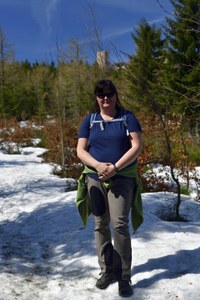Veronika Sacherová

Introduction:
At the Department of Ecology, I am focused on hydrobiology, mainly on freshwater invertebrates from various taxonomic groups. Available student projects (Bc., MSc. and Ph.D.) are usually from one of the following research topics:
1. Molecular ecology and phylogeography of Branchiopoda (Crustacea), predominantly Anostraca and Notostraca
Fairy shrimps (Anostraca) and tadpole shrimps (Notostraca) are among largest branchiopod Crustaceans in Central European waters. They inhabit temporary waters, ranging from vernal pools to puddles in fields and meadows in summer, and have developed adaptations to withstand extensive periods of drought – cysts that are resistant to drying and freezing and stay vial for many years. These cysts moreover present an excellent dispersion agent, they can be distributed on large distances by birds feeding on life branchiopods. The main study topics thus focus on dispersal and phylogeography of the group.
|
|
|
|
Polanská niva locality & sampling, photo: Veronika Sacherová
|
|
|
Eubranchipus grubii, male and female, photo: Martin Černý
2. Phylogeography and phylogeny of the members of the family Chydoridae (Crustacea: Cladocera)
Cladocera of the family Chydoridae remain a neglected group of freshwater zooplankton even though they comprise of some very old genera whose ancestors are readily found in Palaeozoic fossil record. Although chydorids are present in almost every habitat, their population densities are never high and they live mostly in littoral of standing waters, in association with macrophytes and/or substrate. Due to the small body size taxonomic position of many species is unclear, and several cryptic species complexes were detected. Many questions thus remain unanswered – on evolution of the group, interconnection with evolution of aquatic plants, ecology and dispersal (via resting eggs by birds).
 Acroperus harpae, photo: Jan Fott
Acroperus harpae, photo: Jan Fott
3. Impact of acidification on zooplankton communities in mountain lakes
Since the 1950s European ecosystems were impacted by anthropogenic acidification when sulphur and nitrogen compounds from burning of fossil fuels in industry led to acid rains. Despite the decrease of emissions of these compounds since the 1990s, ecosystems are delayed in their recovery. The most profound effect of acidification is seen in mountainous areas (due to high precipitation and bedrock type), and mountain lakes are my research interest, specifically zooplankton – colonization and dynamics in newly established communities.
|
|
|
Jelení jezírko a huminové kyseliny rašelinných vod, foto: Veronika Sacherová
Teaching:
In Czech:
- Microscopic techniques MB160C45
- Biology of freshwater invertebrates MB160P14
- Biology of freshwater invertebrates – field course MB160C14
- Determination of zooplankton, weekend course
- Field course in ecology MB162T02
- Zooplankton of Europe – determination course MB162T03
- Ecology of aquatic organisms MB162P34
In English:
- Crustacean biology and diversity MB160P06
- Limnology MO550P126E
- Ecology of lentic ecosystems MB160P02
Publications:
- Vávra J., Hyliš M., Fiala I., Sacherová V., Vossbrinck C.R. (2017). Microsporidian genus Berwaldia (Opisthosporidia, Microsporidia), infecting daphnids (Crustacea, Branchiopoda): Biology, structure, molecular phylogeny and description of two new species. EUROPEAN JOURNAL OF PROTISTOLOGY 61: 1–12. (IF 2018: 2,6)
- Vrba, J., Bojková, J., Chvojka, P., Fott, J., Kopáček, J., Macek, M., Nedbalová, L., Papáček, M., Rádková, V., Sacherová, V., Soldán, T., Šorf, M. (2016): Constraints on the biological recovery of the Bohemian Forest lakes from acid stress. FRESHWATER BIOLOGY, 61: 376–395. (IF 2018: 3,4)
- Juračka P.J., Sacherová V., Dobiášovská I., Bovšková D., Novosadová Z., Kořínek V., Petrusek A. (2016): Simplification of preparation techniques for scanning electron microscopy in Cladocera: preparing filtering limbs and ephippia for efficient studies of ultrastructure. CRUSTACEANA, 89(1): 47–62. (IF 2018: 0,8)
- Faustova, M., Sacherova, V., Svensson, J.E., Taylor, D.J. 2011. Radiation of European Eubosmina (Cladocera) from Bosmina (E.) longispina-concordance of multipopulation molecular data with paleolimnology. LIMNOLOGY AND OCEANOGRAPHY, 56 (2): 440-450. (IF 2018: 4,3)
- Faustova, M., Sacherova, V., Sheets, H.D., Svensson, J.E., Taylor, D.J. 2010. Coexisting Cyclic Parthenogens Comprise a Holocene Species Flock in Eubosmina. PLOS ONE, 5 (7): Art. No. e11623. (IF 2018: 2,8)
- Adamowicz SJ, Sacherova V, 2006. Testing the directionality of evolution: the case of chydorid crustaceans. JOURNAL OF EVOLUTIONARY BIOLOGY 19 (5): 1517-1530. (IF 2018: 2,5)
- deWaard JR, Sacherova V, Cristescu MEA, Remigio E.A., Crease T.J. & Hebert P.D.N. 2006. Probing the relationships of the branchiopod crustaceans. MOLECULAR PHYLOGENETICS AND EVOLUTION 39 (2): 491-502. (IF 2018: 4,0)
- Sacherova V, Krskova R, Stuchlik E, Horicka, I. Hudec, J. Fott. 2006. Long-term change of the littoral Cladocera in the Tatra Mountain lakes through a major acidification event. BIOLOGIA 61 (Suppl. 18): S109-S119. (IF 2018: 0,7)
- Sacherová, V. and P.D.N. Hebert. 2003. The evolutionary history of the Chydoridae (Crustacea: Cladocera). The Biological Journal of the Linnean Society 79: 629-643. (IF 2018: 2,2)
- Kořínek, V., Sacherová, V., and L. Havel., 1997. Subgeneric differences in head shield and ephippia ultrastructure within the genus Bosmina Baird (Crustacea, Cladocera). HYDROBIOLOGIA 360: 13-23. (IF 2018: 2,3)
Document Actions






